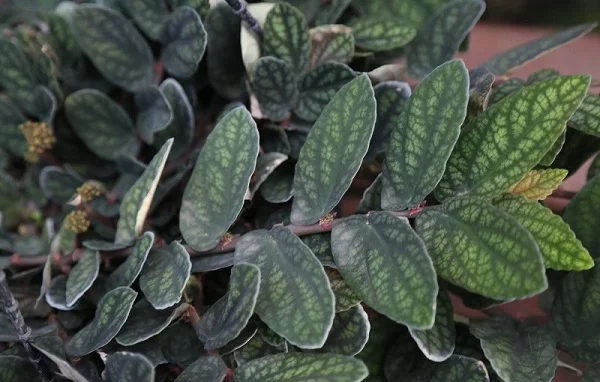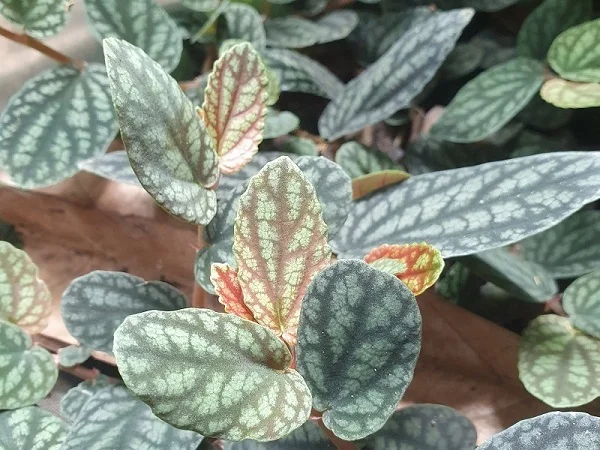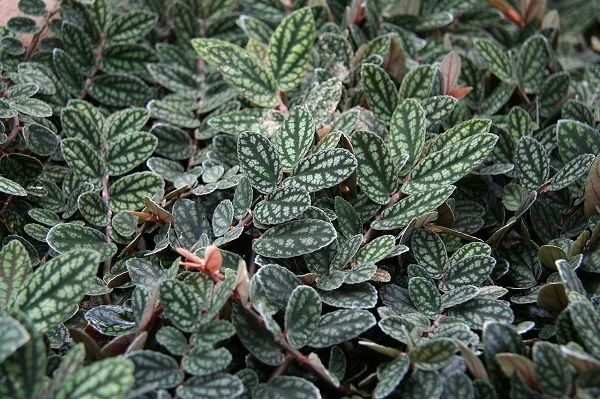Satin Pellionia (Pellionia pulchra) Care, Pruning, Propagation and Common Problems
Some links in this post may be affiliate links
Satin Pellionia (Pellionia pulchra) thrives in medium to bright light, warm and humid conditions and consistently moist, rich, well-drained, all purpose potting soils coupled with monthly feeding during the growing season.
In this guide, you will learn everything you need to know about growing and maintaining Satin Pellionia indoors, from light and watering to propagation and troubleshooting common issues. First let's get to know some facts about this striking plant.
Pellionia pulchra also called Watermelon Pellionia is a relatively low-maintenance plant which bears small variegated leaves in green and silver, with trailing darker stems making it perfect for a hanging basket.
Watermelon Pellionia has a high humidity requirement and does not like cold drafts placing it among the best plants for a closed terrarium or a bottle garden where warm, humid conditions are achievable.

Botanical name: Pellionia pulchra
Family: Urticaceae
Common names: Satin Pellionia, Watermelon Pellionia
Origin
Pellionia pulchra is native to South East Asia in Burma, Malaysia and Vietnam.
Related Plants
Another variety of Pellionia that is grown indoors is Pellionia repens ( Polynesian Ivy Vine) which bears a pale central band on each leaf with an olive or bronzy green outer margin.
Is Satin Pellionia pet-friendly?
Satin Pellionia is non-toxic to humans and pets as outlined by ASPCA. It is safe to grow in the home or office space.
Where to Buy
If you are looking to add Pellionia Plants to your collection, you may acquire these plants online from Etsy (Link to Etsy).
Satin Pellionia Care Indoors
Now, let’s dive into the details of how to care for Satin Pellionia indoors.
To care for Satin Pellionia (Pellionia pulchra) give it medium to bright indirect light, average warmth of 18-260C, humidity of 60-70% and consistently moist, rich, well-drained, potting mix coupled with monthly feeding during the growing season.
Pellionia pulchra care requires regular pruning to keep the plant neat and tidy, to encourage a bushy growth as well as get rid of the insignifacant flowers to redirect energy to growth. Repotting is only needed when the plant becomes extremely pot-bound. Keep reading for more on the best growing conditions and how to achieve them.

Watering
Water your Satin Pellionia liberally during the growing season and keep the soil moist through out. Avoid overwatering as it can lead to yellowing leaves and mushy stems.
Decrease watering in the cold season to keep the soil slightly moist. Never leave the soil to dry out completely to avoid drooping and crispy leaf edges.
Ensure that the soil is free-draining and the pot has a drainage hole to prevent the soil from getting soggy as it can lead to root-rot and loss of the plant.
Pro tip: Satin Pellionia loves even moisture, so check the soil every few days to keep it from drying out completely.
Light Requirements
Satin Pellionia grows best in medium to bright indirect light (filtered light). Keep it away from direct sunlight as it can cause scorching on the leaves (unsightly brown marks on the leaves).
If your plant’s leaves fade or become leggy, move it to a brighter spot or use a grow light if the natural lighting is insufficient.
Rotate the pot regularly to ensure that the plant receives light on all sides for a balanced growth as well as prevent legginess.
Temperature and Humidity
Pellionia pulchra requires an average warmth of 18-260C. Keep it away from cold drafts as too cold temperatures can cause stunted growth and leaf drop.
Satin Pellionia prefers a humidity of 60-70%. Too little humidity will result in leaf curl and brown edges. To improve humidity, set the pot on a wet pebble tray or use a cool mist humidifier. You may also grow the plant in a terrarium as a high humidity and warmth can be maintainted inside a terrarium.
Potting Mix
The best soil for Satin Pellionia should be a light, airy, and moisture-retaining soil mix. A potting mix made up of 1 part peat moss or coconut coir (for moisture), 1 part perlite or orchid bark (improves drainage) and 1 part organic potting mix (provides nutrients) is good for this plant.
Fertilizer
Feed Satin Pellionia with a balanced, water-soluble fertilizer every 4 weeks during the growing period. Stop feeding in the cold season as growth is minimal and feeding at this time may cause fertilizer burn; burnt leaf tips.
Repotting
Repot Satin Pellionia during the growing season only when the plant has become extremely pot-bound as it grows best when the roots are confined.
Use a pot one size larger than the current one and ensure that the pot has a drainage hole to avoid getting soggy soil which can lead to root-rot. Check out these self watering planters on Amazon.
Satin Pellionia Pruning
Pruning Satin Pellionia involves pinching any flower buds as they appear. The flowers require a lot of nourishment from the plant which may affect its proper growth.
Remove any dead foliage frequently to keep the plant tidy and discourage pests and diseases. Pinch off the growing tips to encourage a bushy, compact growth and prevent the plant from becoming leggy too soon.
Pro tip: Use clean, sharp scissors to avoid spreading diseases while pruning.
Pellionia pulchra Propagation
Pellionia pulchra propagation can be done at the beginning of the growing season from stem cuttings or by plant division.
(A) Pellionia pulchra propagation from stem cuttings
Stem cuttings root easily and there is no need for a rooting hormone. The cuttings made rooted in soil or in water.
1. Propagating Pellionia pulchra from stem cuttings in soil
- Take stem cuttings of about 4-5 inches length from a healthy plant. Ensure each cutting has at least one set of leaves and 2-3 leaf nodes.
- Select a rooting container. Ensure it has a drainage hole to prevent the soil from getting soggy to avoid rotting.
- Fill the rooting container with well-drained rooting soil.
- Moisten the soil and make a hole that is slightly wider than the stem of the cutting.
- Insert 2-3 inches of the lower cut end of the cuttings in the previously made hole and lightly firm the soil around it.
- Cover the set up with a plastic bag or use a humidity dome to encourage rooting.
- Place the set up in warm, well-lit place away from direct sunlight to avoid scorching.
- Maintain the soil moist until new growth emerges which indicates rooting and may take 2-4 weeks.
- Once there is substantial growth, transfer the new plants to individual pots in well-drained soil and begin routine care.
2. Propagating Pellionia pulchra from stem cuttings in water
- Take stem cuttings of about 4-5 inches length from a healthy plant. Make sure each cutting has at least one set of leaves and 2-3 leaf nodes.
- Place the cuttings in a jar of plain water or in a propagation station.
- Cover the set up with a plastic bag or a humidity dome to enhance rooting.
- Position the set up in a brightly-lit spot away from direct sunlight and change the water every 5-7 days.
- When the roots are about 2-3 inches, transfer the cuttings into small pots in moist, well-drained soil.
- Place the pots in a warm place under bright indirect light to avoid scorching.
- Keep the soil moist until new plants are well established.
- When the plants are well established, transplant into a pot 1 size larger in well-drained soil after which you can begin routine care.
Pro tip: For a fuller plant, transfer several cuttings into one pot.
(B) Pellionia pulchra propagation by plant division
This method of Pellionia pulchra propagation is best for large plants which may have outgrown their pots. Division of plants is a faster and succesful way of multiplying your plants.
3. Propagating Pellionia pulchra by plant division
- Water the plant thoroughly at least one day before to make it easier to divide and also hasten establishment. A well hydrated plant suffers less shock and takes a shorter time to take root.
- Slip the plant out of its pot and carefully divide it into several sections. Confirm that each sections has adequate roots.
- Select a 6 or 8 inches pot and ensure it has a drainage hole to prevent the soil from getting soggy to avoid rotting.
- Fill the pot with free-draining, potting soil and moisten it lightly.
- Make a hole in the center of the pot. Ascertain that the hole is slightly wider than the root base of the section.
- Place the section in the previously made hole and lightly firm the soil around the base. Take care to maintain it at the same soil level it was in the previous pot.
- Wet the soil thoroughly and place the set up in a well-lit, warm place away from direct sunlight.
- Allow the new plant to be well established after which you can begin routine care.

Pellionia pulchra Problems
Satin Pellionia problems include brown leaf tips, wilting, leaf drop, powdery mildew, pests and diseases among others. Keep reading for more on these problems, their remedies and solutions.
Brown leaf tips and edges
Brown leaf tips and edges in Satin Pellionia are caused by dry air. To raise the humidity, set the pot on a wet pebble tray or grow the plant in a well-lit bathroom, kitchen and other moist areas in the the home. You may also grow the plant in a closed terrarium where a high humidity can be maintainted.
Brown, wilting leaves
Satin Pellionia brown, wilting leaves are due to underwatering. Water when the top 1-2 inches of soil dry out and never allow the soil to dry out completely.
Leaf drop
Leaf drop in Satin Pellionia is due to sudden drop in temperature as a result of exposure of the plant to cold drafts. Keep the plant away from drafty windows, AC units, windy doors and others to maintain an average warmth of 18-260C.
Brown-grey dust on the leaves
Brown-grey dust on the leaves of Satin Pellionia is an indication of powdery mildew which is prevalent in a warm humid environment. Isolate the affected plant to prevent spread to other plants and treat it with an insecticidal soap or neem oil. In addition, make sure that there is free air flow for your plant to minimize disease infestations.
Pests
Common pests in Satin Pellionia are aphids, scale insects, whiteflies and mealybugs. Isolate the affected plant to prevent spread to the other plants and treat it accordingly. Learn how to identify and control houseplants pests.
Summary: Satin Pellionia Care
- Lignt: Bright indirect light
- Water: Keep the soil consistently moist and never soggy
- Humidity: High humidity (above 50%)
- Temperature: Average warmth (18-260C)
- Feeding: Monthly with a balanced, water-soluble fertilizer
- Soil: Well-draining, rich organic mix
- Pruning: Remove dead leaves and flowers, pinch off growing tips, cutback leggy stems
- Repotting: When extremely pot-bound
- Propagation: Stem cuttings, division
Conclusion
Satin Pellionia is a stunning, low-maintenance trailing plant that thrives in bright, humid environments. With proper care, regular watering, pruning, and the right light, this plant will reward you with lush, vibrant foliage for years to come.
Frequently Asked Questions
1. Can Satin Pellionia grow in low light?
Satin Pellionia can survive in medium light, but it thrives in bright indirect light.
2. Is Pellionia pulchra a fast grower?
Yes. Pellionia Pulchra grows quickly, especially in warm, humid conditions.
3. Can I grow Satin Pellionia in a terrarium?
Satin Pellionia is perfect for terrariums due to its high humidity needs.
4. How do you propagate Pellionia pulchra?
Pellionia pulchra is propagated from stem cuttings and by plant division during the growing season (spring and summer).
You liked it? Share on social media.
Related Content
Amazon Associates Disclosure
Homeplantsguide.com is a participant in the Amazon Services LLC Associates Program, an affiliate advertising program designed to provide a means for sites to earn advertising fees by advertising and linking to amazon.com.





